Pond Management Updates: Our Blog of Weed Treatments, Surveys, Closures, and Observations
This is the place for the latest news on the health of Foster's Pond. Since 2004, the Foster's Pond Corporation has actively managed the Pond, treating for invasive weeds and algae while conducting systematic vegetation surveys to ensure a vibrant ecosystem of native plants. We've chronicled everything. Scroll down to see entries from 2020 to the present. For 2004 through 2019, click here.
2025: On Guard for Algae (and Maybe Spiny Naiad)
Main Pond Gets 2d Algae Treatment
Main Pond Reopens After Algae Treatment
Conservation Commission Approves Hydro-Raking and a Little Treatment, If Needed
2024: Nine Years After a Widespread Fanwort Treatment, Survey Finds Need for Another
Conservation Commission Extends FPC Role Through 2027
Pond Found in Good Shape After Fanwort Treatment
Main Pond Gets Late-Season Algae Treatment
First Pond-wide Treatment Since 2015 Takes on Fanwort
Consultant Recommends Treating 40 Acres
2023: Diving Takes Center Stage in Fanwort Program
Main Pond and Outlet Cove Treated for Blue-Green Algae
In Their Season Finale, Divers Bag Another 1000 Pounds of Fanwort, Bringing Total to Two Tons
Divers Remove a Ton of Fanwort
Exit the Hydro-Rake, Enter the Divers
Dug Pond Treated for Fanwort
Conservation Commission Greenlights 2023 Lake Management Program
Consultant: Dug Pond Needs Fanwort Treatment, But Foster's Pond Doesn't (Cue the Divers)
2022: Fanwort and Algae Remain Top Concerns
Annual Survey: Fanwort Strategy Is Working
After a Break, Diving for Fanwort Resumes
'Main Pond' Basin Treated for Blue-Green Algae
Divers Pull Fanwort from Untreated Basins
Outlet Cove and Azalea Basin Receive "Booster" Weed Treatment
Fanwort Treatment Targets Outlet Cove and Azalea Basin
Conservation Commission Approves Treatment Program for 2022
Consultant Recommends Treatment and Diving Continue Based on 2021 Survey
2021: Targeting Infestations with Spot Treatments and Hand-Pulling
Conservation Commission Extends FPC Role for Three Years
Divers Pursue Fanwort Where Chemical Treatments Left Off
Two Treatments Combat Blue-Green Algae Thriving on Unrelenting Heat and Rain
Mill Reservoir Gets Booster Treatment for Fanwort
Mill Reservoir Treated for Fanwort
Conservation Commission Approves 2021 Lake Management Program
2020 Vegetation Survey Recommends Mill Reservoir Treatment
2020: A Mix of Familiar and Experimental Control Techniques
Dive Team Takes on More Fanwort
Channel Treated for Spiny Naiad
Health Advisory: Stay Alert for Blue-Green Algae
2nd Booster Treatment Applied to Fanwort Target Area
Divers Finish Their Work at Primary Targets
1st Booster Treatment Applied to 1.5-Acre Target Area
Non-Chemical Weed Management in the Spotlight
1.5 Acres Get Fanwort Treatment After Conservation Commission OKs Plan
2019 Year-End Report Sets Stage for 2020
Main Pond Gets 2d Algae Treatment
August, 2025
Less than a month after the Main Pond was treated for blue-green algae, elevated counts turned up again, triggering the need for a second treatment of the Pond's largest basin. It was the first summer in four years that the Pond has had two algae treatments.

August 1: Aquatic technicians Vinny Notaro (left) and Riley Tournas prepare their 16-foot airboat to infuse copper sulfate into the Pond to kill blue-green algae.
Only the Main Pond basin was treated. Dug Pond and the basins of Foster's Pond showed no signs of blue-green algae, which can cause gastrointestinal distress in children and be fatal to pets.
Main Pond Reopens After Algae Treatment
July, 2025
The Main Pond was treated for blue-green algae July 7. Volunteers have been out on the Pond, scouting for signs of algal blooms. A sample drawn from the Main Pond on June 30 was sent out for laboratory analysis and found to have elevated concentrations of blue-green algae - well below the threshold at which health authorities recommend no contact with the water, but high enough to warrant a treatment.

Aquatic technician Vinny Notaro cruises the Main Pond with a full tank of copper sulfate. The blue liquid solution is pumped from the tank and infused into the Pond through the hose trailing from the stern.
The Main Pond - the largest basin in Foster's Pond - was treated with copper sulfate, in accordance with protocols approved by the Andover Conservation Commission. The Main Pond was closed for the day, reopening on July 8.
Conservation Commission Approves Hydro-Raking and a Little Treatment, If Needed
May, 2025
The Andover Conservation Commission unanimously approved the Corporation's lake management recommendations for 2025, signing off on a list of ten hydro-raking participants as well as contingency plans to treat for blue-green algae and spiny naiad, if necessary.
The vote came at the Commission's May 20 meeting, following on the heels of the body's decision last December to extend for another three years the long-standing Order of Conditions which authorizes a lake management program for Foster's Pond.
Hydro-raking is slated to begin June 2. Eight shoreline owners on the Main Pond and two on the Channel signed up for the 2025 program.
Following last year's Pond-wide treatment for fanwort, the Corporation recommended that the Commission authorize a much more modest treatment program for 2025 - applying copper sulfate if blue-green algae counts rise to levels that portend a dangerous bloom, and treating spiny naiad if a midsummer survey finds any large infestations.
It has proved necessary to treat for blue-green algae almost every year since 2012, but the last spiny naiad treatment was in 2018.
Conservation Commission Extends FPC Role Through 2027
December, 2024
The Andover Conservation Commission unanimously extended for three years the long-standing Order of Conditions which authorizes a lake management program for Foster's Pond and designates the Foster's Pond Corporation as the entity in charge of implementing it.
The vote, which came at the Commission's December 3 meeting, continues an integrated management program first authorized in 2005. The Order covers herbicide use, winter drawdowns, hydro-raking, and nutrient management. The Order has been amended from time to time, as new chemicals and non-chemical alternatives became available - and as additional invasives and blue-green algae emerged as problems.
The Commission extended the current Order, due to expire on January 4, 2025, to January 4, 2028, making no changes in the program. Three years is the maximum period for which an Order can be extended, although there is no limit on the number of extensions which may be granted.
Pond Found in Good Shape After Fanwort Treatment
November, 2024
Following the Pond's most extensive treatment for invasive weeds in nine years, a systematic survey of vegetation and water quality found native plant species thriving and the water in all basins within desirable parameters.
This year's vegetation survey, for the first time, mapped locations of a dozen of the native plant species found in Foster's Pond. Click on the image to see an enlargement.
The data and conclusions are set out in a 53-page year-end report prepared by Solitude Lake Management, the Corporation's long-time consultant. Two biologists crisscrossed the Pond in late August, dragging the bottom to sample plant species at 61 preset data points. Most of the data stations were programmed into a GPS system in 2004, when the Corporation commissioned its first systematic vegetation survey. The 2024 survey was the Corporation's 17th.
The surveys, now undertaken annually, are designed to track invasive and native plant populations, track changes due to management efforts, document the biodiversity of aquatic vegetation, and assess water quality.
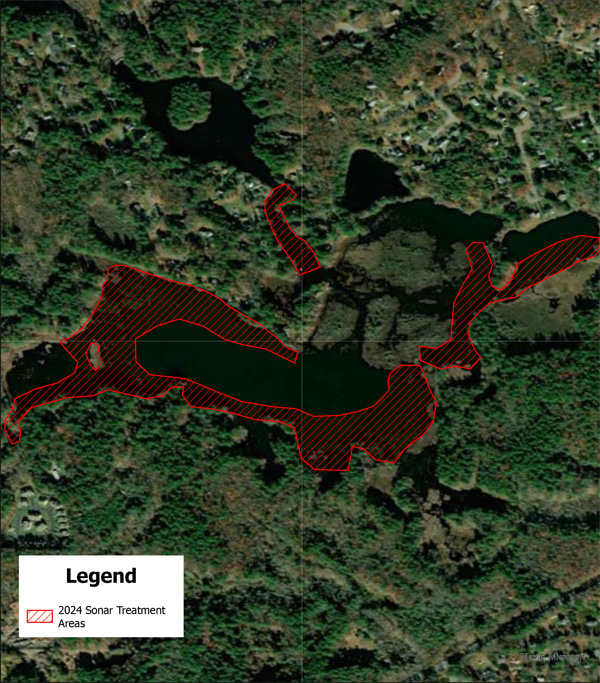
About 42 of the Pond's 120 acres were treated for fanwort in 2024, the most extensive treatment of invasive weeds since 2015. Some of the densest fanwort stands were choking the waters near the Goldsmith Woodlands.
The 2024 survey, coming at the tail end of a summer-long fanwort treatment covering 42 of the Pond's 120 acres, found small, sickly stands of fanwort at only two of the 61 sampling points - both of them outside the treatment areas. The biologists concluded that the treatment was "highly successful."
The biologists identified 14 native plant species, a number which has varied from year to year but, as the report put it, has been "relatively stable" since the last major fanwort treatment in 2015. This year, for the first time, the biologists mapped locations of a dozen native species, which were found both within and outside the treatments areas. Fanwort, left uncontrolled, forms dense stands which outcompete native plants, reducing biodiversity; knocking out the fanwort tends to increase the number and extent of native species.
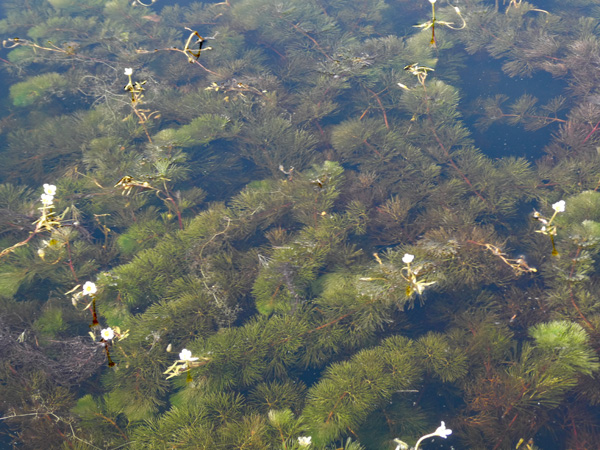
September 6, 2023: Fanwort growing in the Main Pond, near the Goldsmith Woodlands. Dense infestations clogged much of the Pond, triggering an extensive treatment program in 2024.
As in previous surveys, surface samples were taken five locations and sent to a laboratory for water quality analysis. Two notable findings: this year, only the Main Pond exhibited a higher-than-desirable concentration of phosphorus, and fecal coliform levels in all basins were below the threshold for swimmable waters in Massachusetts. Not surprisingly, the higher phosphorous level in the Main Pond came precisely at the time when a blue-green algae bloom triggered the need for a late-season copper sulfate treatment.
Main Pond Gets Late-Season Algae Treatment
September, 2024
In a summer when many ponds in the area were closed by high algae counts, it looked like Foster's Pond might get a free pass. It was not to be.
Laboratory analysis of a water sample from the Main Pond collected in late August revealed elevated levels of the noxious algae, which can pose a health hazard. As a consequence, the Pond's largest basin was posted with warning signs over Labor Day week-end and treated with an algaecide on September 3.

September 3: Aquatic specialist Connor Emsley from Solitude Lake Management sprays a solution of copper sulfate in the Main Pond to kill blue-green algae. The commonly-used algaecide is applied in accordance with an Order of Conditions approved by the Andover Conservation Commission.
Volunteers had been keeping a watchful eye on water clarity throughout the Pond during the summer. A drop in clarity is often an indicator of a potential algae problem. So is the presence of blue-green scum, which is usually spotted first along shorelines.
No scum had been sighted anywhere in the Pond, but clarity had slowly headed downhill in August. Coincidentally, the Corporation's annual vegetation survey was scheduled for August 20, and it was a routine water sample from that survey which revealed the presence of blue-green algae in higher-than-expected concentrations in the Main Pond.
First Pond-wide Treatment Since 2015 Takes on Fanwort
Updated: August, 2024
Foster's Pond has been undergoing its most extensive treatment for invasive weeds in nine years. Forty-two of the Pond's 120 acres have been treated with a slow-acting herbicide in a summer-long process involving three applications of the chemical - plus a fourth in one area where infestations proved particularly obstinate..
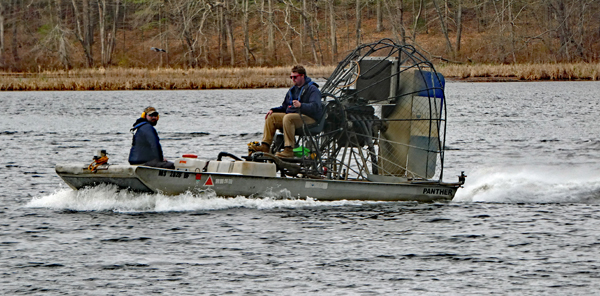
May 2: Aquatic technicians Andrew Merita (left) and Vinny Notaro (at the controls) warm up their airboat on the Main Pond as they prepare to administer the most extensive fanwort treatment since 2015. The Corporation employs its long-time consultant, Solitude Lake Management, to treat the Pond.
The target was fanwort, the Pond's most persistent invader. Fanwort was the dominant plant in Foster's Pond in 2005, when the Corporation began a lake management program to control nuisance vegetation. Fanwort covered more than half of the open water crowding out native vegetation. Fanwort forms mats which can become so dense that fish are trapped and can suffocate.
Fanwort is almost impossible to eradicate once it becomes established. But by a judicious combinations of periodic chemical treatments and hand-pulling by divers, the Corporation has kept it in check. Most years since the program began, fanwort has been found in less than 10 per cent of the Pond, and often it has been virtually undetectable. However, by the end of last summer - after a season of perfect growing conditions - it covered an estimated 17 per cent of the Pond, with dense stands far beyond the ability of divers to remove. Fanwort clogged much of the Main Pond, extending into the Mill Reservoir and the Channel.

September 6, 2023: Fanwort growing in the Main Pond. Dense infestations clogged much of the Pond, triggering an extensive treatment program in 2024.
This year's fanwort treatment began on May 2. The treatment process consists of dispersing clay pellets infused with fluridone, a slow-acting herbicide sold under the brand name Sonar. It is the most effective - and safest - chemical authorized for fanwort control in Massachusetts. Sonar is applied at very low concentrations - 10 parts per billion or less, half of what is allowed in public drinking water reservoirs.
The Sonar is released gradually as the pellets slowly break apart in the water, maintaining a relatively steady concentration over a period of about 30 days. At that point, a booster treatment is necessary to keep the process going. It takes about 90 days for Sonar to kill fanwort.
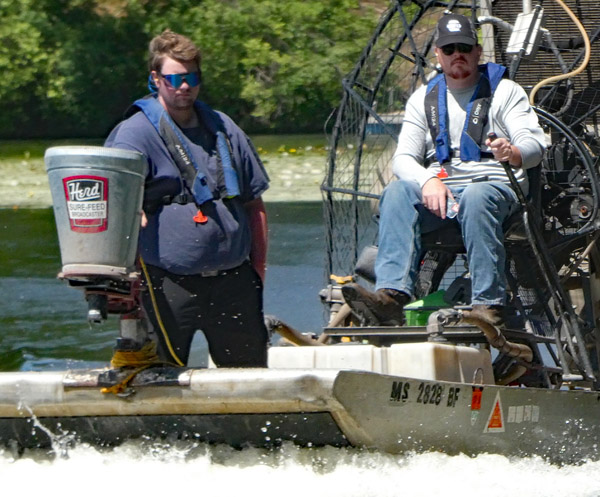
June 3: Associate Project Manager Mike Tartaglia (left) and Aquatic Technician Vinny Notaro (at the helm) keep an eye on the mechanism broadcasting Sonar-infused clay pellets in the Main Pond.
The May 2 treatment was followed on June 3 with a "booster" treatment. The herbicide treatments are usually scheduled about 30 days apart, coinciding with the half-life of the chemical. A second booster treatment was applied on July 2.
In past years, three treatments - the initial application and two boosters - have been sufficient to kill fanwort. That appeared to be the case for most of the areas treated in 2024. An inspection by the Corporation's consultant on July 30 - 88 days after the initial treatment - found no fanwort where dense infestations had blanketed the Pond in September.
But in one area, the fanwort had not yet given up the ghost. In the Channel - the narrow passage running between Foster's Pond Road and Glenwood Road Extension, the neck of the "flying duck" in the Corporation's logo - fanwort was not quite dead, showing green growing tips at the end of bleached-out stalks. On the advice of the consultant, the Corporation scheduled a third booster, just for the Channel, on August 7.
Under protocols approved by the Andover Conservation Commission, the Pond was closed for the day of each treatment to minimize chances that the treatment craft would be disrupted by recreational boaters getting in its way.
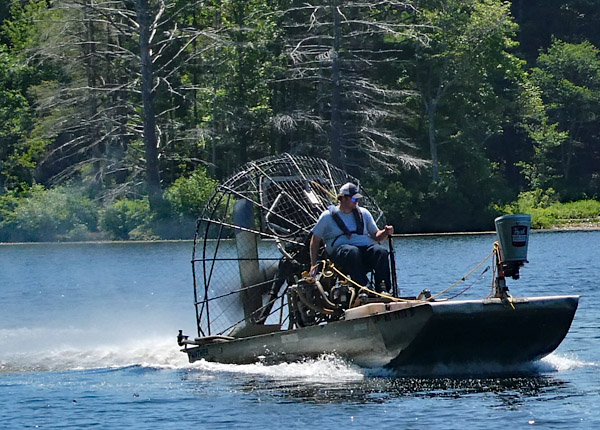
July 2: Aquatic Technician Vinny Notaro navigates the Main Pond, broadcasting the second "booster" application Sonar-infused clay pellets.
The 2024 Sonar treatment was the Pond's most extensive since 2015, when a survey indicated that about 10 per cent of the Pond was covered with fanwort.
Sonar works by impeding the production of carotene, which acts as a sunblock protecting the plant's chlorophyll from the bleaching effect of sunlight. Without that protection, the plant gradually whitens and dies, a process known as chlorosis.
Shoreline residents were cautioned not to use treated water for irrigation for 30 days after the final treatment, as the same process might affect some terrestrial plants.
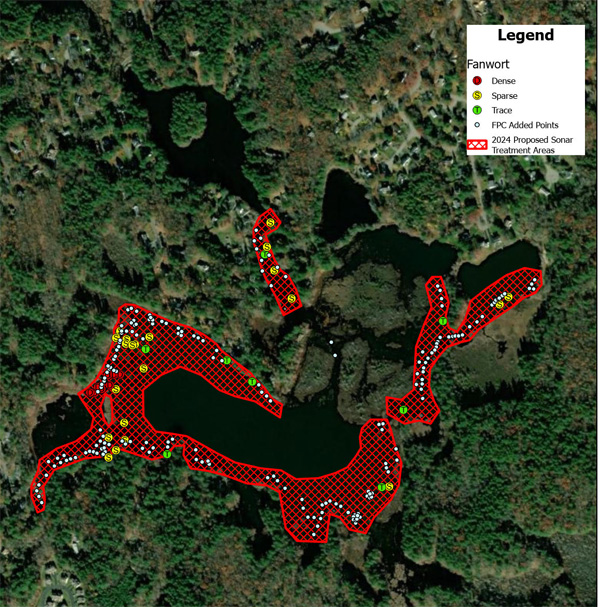
The treatment targeted about 42 of the Pond's 120 acres. Dense stands of fanwort were observed last September in the areas indicated in red on the above map.
The treatment was conducted pursuant to a license issued by the State's Department of Environmental Protection, in accordance with protocols and an Order of Conditions approved by the Andover Conservation Commission. The Commission approved this year's treatment program on March 19.
Consultant Recommends Treating 40 Acres
January, 2024
The Corporation's lake management consultant has recommended treating about 40 of the Pond's 120 acres to combat fanwort, the pernicious and persistent invasive weed that dominated Foster's Pond until 2005. That's when the FPC began a comprehensive lake management program to keep fanwort and other invasives in check.
The recommended treatment would be the first in the Main Pond - the largest basin - since 2019, and the most widespread fanwort treatment since 2015.

The FPC's lake management consultant has recommended treating the areas outlined in red in the map above. That's about 40 of the Pond's 120 acres. Dense stands of fanwort are growing throughout the designated areas. The photo below was taken on September 6 near the Goldsmith Woodlands.

Fanwort is almost impossible to eradicate entirely once it becomes established in a water body. Over the last few years, the FPC has been pursuing a strategy of spot-treating smaller infestations as they emerge, and experimenting with non-chemical alternatives. The aim is to control fanwort and lengthen the intervals between widespread treatments.
The strategy has largely been successful, although most alternatives to chemical treatment have proved ill-suited to Foster's Pond. For example, it turned out to be next to impossible to place portable light-proof barriers over fanwort plants growing in the Pond's deep, silty sediments. Volunteers couldn't stand in the silt, and the barriers kept slicing into the fragile plants, sending fragments off to root elsewhere and spread the infestations.
Diver-assisted suction harvesting ("DASH") likewise proved impractical. The equipment needed to vacuum up weeds, coupled with the expansiveness of a screen needed to filter plant fragments from the torrent gushing from the intake hose, require a larger boat than can be launched into Foster's Pond. Even a smaller, makeshift raft couldn't be maneuvered into the shallow areas where fanwort grows. And as the vacuum hose roiled the sediments, divers found it impossible to see what they were doing.
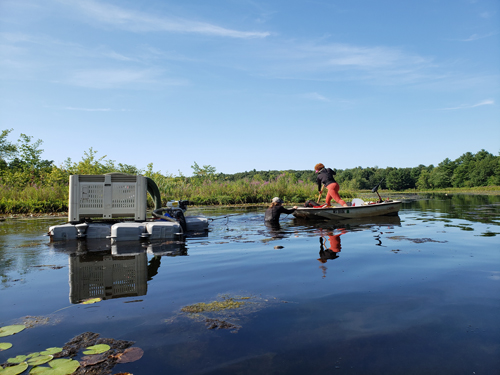
2019: An experiment with DASH in Foster's Pond did not go well. Even with mini-sized equipment, it was a scene straight out of the The African Queen. The diver had to jump into the mucky channel to pull the raft and push the boat for a couple of hundred painfully slow yards, while his assistant poled.
By contrast, hand-pulling by professional divers has shown promise in Foster's Pond. It's a slow, challenging process, with the divers - blinded by the silt - feeling their way to the roots of each plant, plucking them out one by one and stuffing them into a mesh bag. In 2023, divers managed to remove more than 2 tons of fanwort.
But it wasn't enough. The FPC's annual comprehensive vegetation survey of the Pond - coupled with a follow-up examination of the entire shoreline of the Main Pond - found fanwort growing all along the perimeter and extending into deeper water, much of it in dense concentrations.
When fanwort reaches that level, there is no practical alternative to the application of the most effective herbicide authorized by the State - fluridone, sold under the brand name Sonar.
Sonar, by design, is a slow-acting herbicide, administered in low doses over an extended period of time. It acts by interfering with the plant's production of carotene, a sort of botanic sunscreen which protects chlorophyll in the plant from the bleaching effect of the sun's rays. Without carotene, the chlorophyll fades, the plant is unable to produce carbohydrates, and it dies - usually over a period of 30 to 90 days. Biologists regard the slow rate of die-off as a benefit of fluridone, minimizing the risk that decaying plants will deplete oxygen in the water.
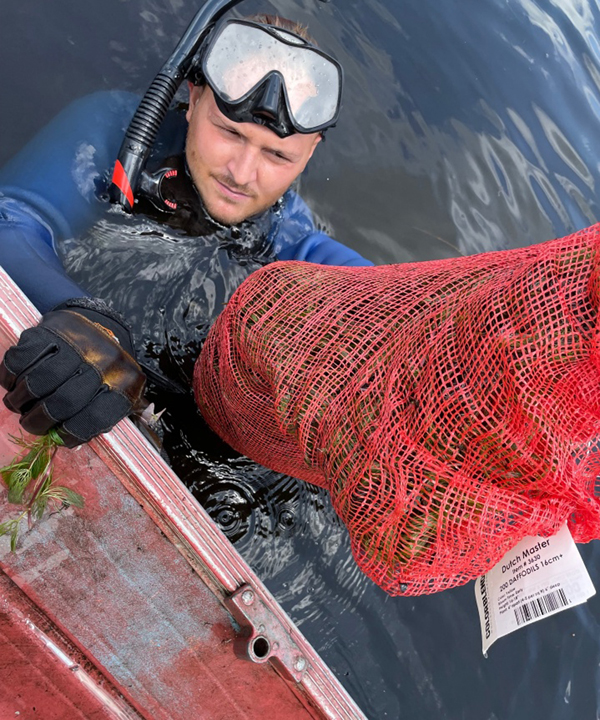
June 2023: A diver boosts a 25-pound bag of fanwort into his team's boat near the Goldsmith Woodlands. And, yes, that's a bit of fanwort caught under his right hand. Photo by Sterling Aquatic, LLC.
Fluridone is applied in extremely low doses, well below what is allowed in public drinking water supplies. Because it has a short half-life, it must be administered in two, three, or sometimes four successive applications to keep the necessary concentration for the bleaching process (known as chlorosis) to run its course.
The Pond will be closed for recreational uses the day of each Sonar application, and residents will be advised not to use Pond water for irrigation during the entire period of treatment. There are no other water use restrictions associated with Sonar applications.
The 2024 treatment plan is subject to approval by the Andover Conservation Commission, and would be carried out in accordance with an Order of Conditions previously approved by the Commission.
The 72-page year-end report for 2023, prepared by Solitude Lake Management, contains a wealth of information about the health of the Pond. It includes analysis of plant life contained in samples raked from the bottom at 61 set data points established since the first comprehensive vegetation survey was conducted for the FPC in 2004. The surveys are now conducted annually. The 2023 survey was the 16th.
The annual surveys also take a snapshot of water quality in five basins of the Pond. The 2023 results indicated concerningly high fecal coliform counts in the Mill Reservoir. Laboratory analysis of the single sample taken from the Mill Reservoir registered a count of 5700 col/mL, far above the acceptable threshold of 235 col/mL for swimmable waters.
Town officials were consulted about the high count. Their consensus was that the likely cause was the extraordinarily high rainfall the day before the sample was drawn. The 5" to 6" downpour probably washed an unusual amount of organic material into the Mill Reservoir, which is at the mouth of Frye's Brook. A sample subsequently collected by the FPC yielded test results below the threshold for swimmable waters.
Main Pond and Outlet Cove Treated for Blue-Green Algae
August, 2023
The Main Pond (the largest basin in Foster's Pond) and the Outlet Cove (the water between the Dam and the Channel, with Rock Island in the middle) were treated for blue-green algae on August 2. (To see a map with basin labels, click here.)
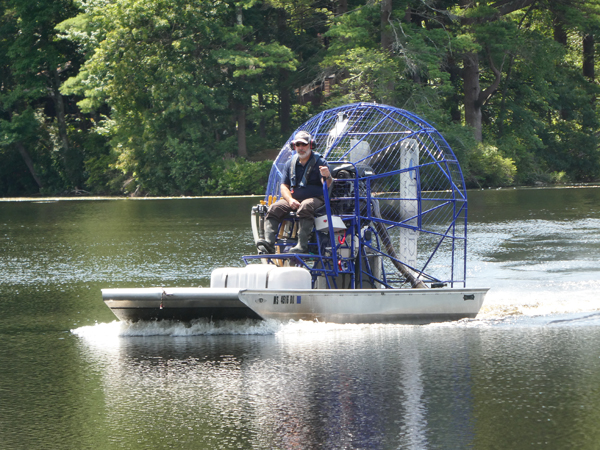
August 2: Dominic Meringolo, senior environmental engineer at Solitude Lake Management, guides an airboat across the Main Pond as he commences a copper sulfate treatment to control blue-green algae.
Laboratory analysis of water samples drawn from the Main Pond and the Outlet Cove on July 26 indicated elevated concentrations of blue-green algae, which can cause gastrointestinal illness in kids and prove fatal to pets. In higher concentrations, adults, too, may experience skin irritations and even more serious health effects. The reported concentrations were 19,000 blue-green algae cells/mL in the Main Pond and 10,000 cell/mL in the Outlet Cove. At 70,000 cells/mL, the Massachusetts Department of Public Health recommends that people have no contact with the water.
Although the concentrations in the Main Pond and the Outlet Cove were well below the MDPH no-contact threshold, blue-green algae can multiply explosively, especially in hot weather. To forestall an algae bloom that would present a health concern, the Corporation arranged for a copper sulfate treatment of both basins.
As they have done for years, volunteers over the summer have been observing water clarity in both basins, as well as the Mill Reservoir and the Azalea Drive Basin. Declining clarity can be a sign of increasing levels of algae. Based on the water clarity observations, a sample was also taken from the Mill Reservoir, but the concentration there was only 1400 cells/mL, a level deemed so low that no treatment was warranted.
Algae treatments - like other chemical treatments of Foster's Pond - are administered in accordance with an Order of Conditions issued by the Andover Conservation Commission. Under the OOC, the Commission annually must approve specific plans and protocols for chemical treatments. The Commission approved the 2023 program on May 9.
In Their Season Finale, Divers Bag Another 1000 Pounds of Fanwort, Bringing Total to Two Tons
July, 2023
Divers returned for their third and final round of hand-pulling infestations of fanwort, the once-dominant invasive weed that remains the Pond's most persistent threat to a balanced ecosystem.
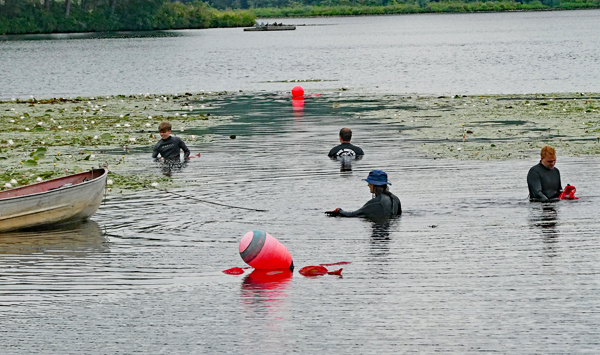
July 27: Dive team searches a portion of the Main Pond for fanwort.
A four-man team spent two days during the last week of July, working mostly in chest-deep water near the westerly shore of the Main Pond. Garbed in wetsuits and wearing snorkel gear, they submerged to pluck out the bright green plants by the roots and stuff their plunder into mesh bags.
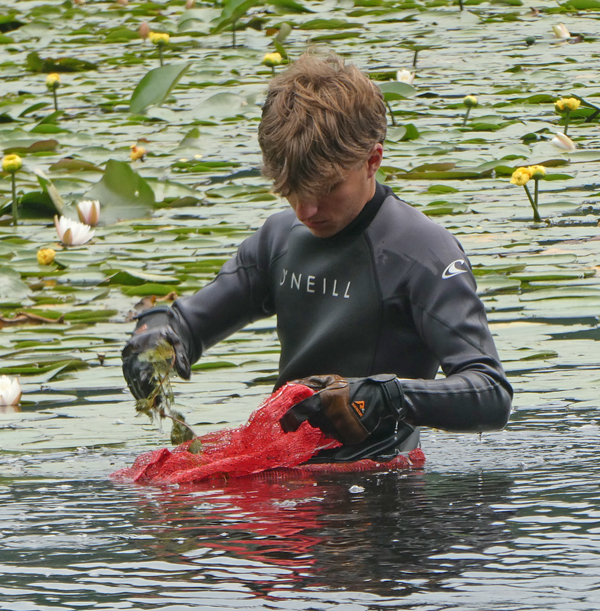
July 27: Diver A.J. Beaulieu loads his mesh bag with a fanwort plant plucked from the bottom of the Main Pond.
The team also scoured the mouth of the Mill Reservoir for a few infestations.
The effort netted 79 bags of fanwort - just under a ton. Added to the 109 bags collected by divers during two earlier deployments, the total haul came to nearly about 2⅓ tons of fanwort removed from the Pond this year without recourse to chemical treatment.
And that is the point of using divers as part of the Corporation's efforts to control nuisance vegetation. While chemicals are more cost-effective for large, dense stands of fanwort, chemical treatments can't be applied to smaller colonies. The only truly effective chemical - fluridone, sold under the brand name Sonar - dissipates rapidly throughout the water body but must be kept at a certain concentration for 60 to 90 days. Rather than wait for small colonies to expand to the point where treating several acres or an entire basin becomes cost-effective, the Corporation has, since 2019, deployed divers to hand-pull smaller infestations, forestalling the need for applying chemicals on a wider scale.
The strategy appears to be working. The last time any portion of the Main Pond was treated for fanwort was 2019.
Divers Remove a Ton of Fanwort
June, 2023
Just before the holiday week-end, divers wound up their sixth day on the Pond, plunging down to the murky sediment to pull out fanwort by the roots. The three-man team, wearing wet suits and snorkel gear, spent most of their time in the Main Pond, working an expansive stand of the invasive weed about 25 yards from the shoreline of the Goldsmith Woodlands.

June 30: Quinten Arsenault boosts a 25-pound bag of fanwort into the dive team's boat near the Goldsmith Woodlands. And, yes, that's a bit of fanwort caught under his right hand. Photo by Sterling Aquatic, LLC.
While underwater, the divers stuffed the fanwort into mesh bags, with each full bag holding about 25 pounds. The divers deposited each bag in their boat, and when the boat was full, transported the bags to shore for trucking to an off-site location.
In all, the dive team removed 109 bags of fanwort - amounting to about 2,725 pounds, or a staggering one-and-a-third tons.
Exit the Hydro-Rake, Enter the Divers
June, 2023
Divers began the tedious task of hand-pulling fanwort in scattered locations around the Pond. A three-man crew set out on June 19, following a map of fanwort colonies provided by a biologist who scoured the shoreline earlier in the month looking for stands of the invasive weed that once dominated the Pond.
The aim is to keep chemical treatments to a minimum by keeping fanwort density below the level at which there is no other choice. The last whole-lake treatment of Foster's Pond was in 2015.
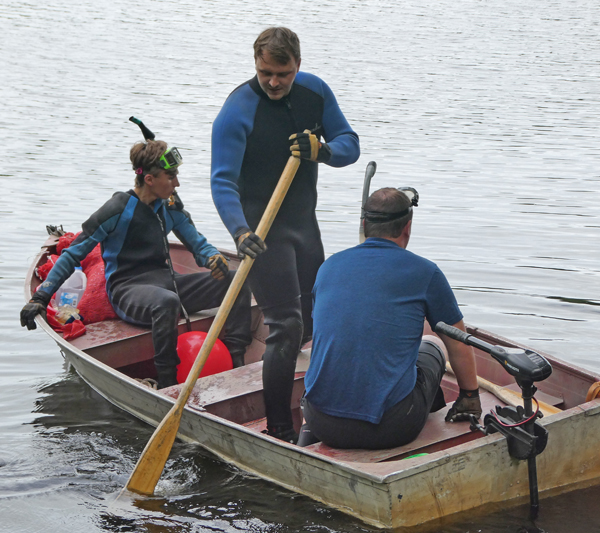
June 19: Dive team from Sterling Aquatic LLC sets out to hand-pull fanwort. For team leader Quinten Arsenault (standing), it was the second year diving at Foster's Pond.
The divers came in just as the hydro-rake was about to depart. Fourteen shoreline property owners - the largest number in 20 years - signed up for hydro-raking in 2023, requesting a total of 71 hours of work. That's more than in most years, but not by much.
Unlike chemical treatments of the Pond and the deployment of divers - both of which are paid for by the Corporation - hydro-raking is financed entirely by those who choose to have their shoreline raked. Each participant is also responsible for the removal of spoils, which are placed on the shoreline property.
Hydro-raking and chemical treatments are conducted by the Corporation's consultant, Solitude Lake Management. Diving for the last two years has been undertaken by Sterling Aquatic LLC.
The divers first targeted plants in the Channel and in the passage between the Main Pond and the Azalea Drive Basin. They then moved to the Main Pond, discovering dense stands along the southeasterly shore, in the vicinity of the Goldsmith Woodlands. The biologist had spotted some fanwort in that area, but the divers saw much more growing in water about eight feet deep. At that depth, it is almost impossible to see the bottom from the surface, particularly if the sky is cloudy or the wind is up.
The divers planned to work at Foster's Pond for three days in June, returning if needed in early July.
Dug Pond Treated for Fanwort
June, 2023
Dug Pond was treated to control fanwort, marking the first time since 2015 that an herbicide was used to combat the persistent invasive in the Town-owned swimming hole.
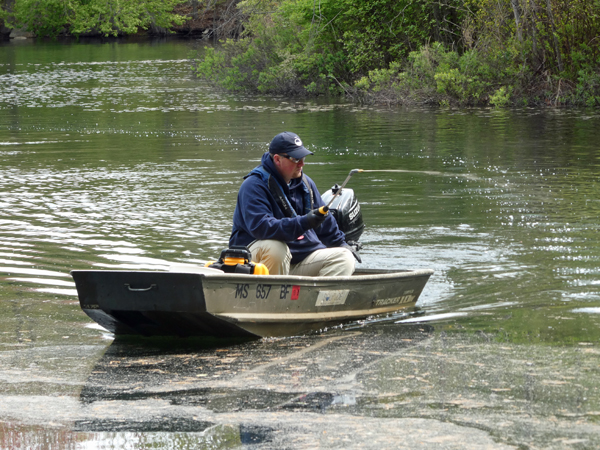
May 15: Aquatic Specialist Vinny Notaro from Solitude Lake Management applies a liquid formulation of fluridone (sold under the brand name Sonar), as he slowly steers his jon boat along the shoreline of Dug Pond. Fanwort thrives in shallow water.
Fanwort, once the dominant plant in Foster's Pond before the Corporation began its lake management program in 2005, had spread to adjacent Dug Pond. Chemical treatments of Dug Pond every few years kept the fanwort in check, and, more recently, divers were able to hand-pull enough of it to slow its spread.
Last year, however, divers found so much fanwort in Dug Pond that they recommended another chemical treatment, and the Corporation's lake management consultant concurred. The Andover Conservation Commission in May approved the treatment plan, and an initial dose was applied to the 3.9-acre Town-owned swimming hole on May 15. A "booster" treatment was applied on June 12.
One or two "booster" treatments, at intervals of about 30 days, are par for the course in the application of fluridone. The slow-acting herbicide works over a period of 60 to 90 days, and has a short half-life, so a repeated dose or two is necessary to maintain the proper concentration.
A water sample taken on June 6 showed a fluridone concentration of 8.6 parts per billion in Dug Pond - right in the range of what's needed to kill fanwort, and well below the 20 ppb concentration allowed in public drinking water reservoirs.
Conservation Commission Greenlights 2023 Management Program
May, 2023
The Andover Conservation Commission unanimously approved the Corporation's recommendations for Pond management in 2023, setting the stage for treating Dug Pond to control fanwort and allowing 14 shorefront property owners to hydro-rake their shorelines.
Weed treatment plans follow the advice of the Corporation's consultant, Solitude Lake Management, contained in a year-end report submitted last December. The Conservation Commission voted to adopt the recommendations on May 9.
The treatment of Dug Pond was scheduled to begin on May 15 with the first of three applications of fluridone (sold under the brand name Sonar), the most effective herbicide for controlling fanwort allowed by Massachusetts regulators. The low-dose chemical - which is regarded as so safe that it can be used in public drinking water reservoirs - works slowly over the course of 90 days. To maintain the proper concentration, it usually must be reapplied twice at intervals of 30 days.
To avoid interrupting the carefully calibrated application of the chemical, the treated water body is closed for the day of treatment. Shoreline owners are advised not to use treated water for irrigation for the duration of the 90-day treatment regimen.
Under the Order of Conditions which governs the Corporation's lake management program, treatment plans must be approved annually by the Conservation Commission. This year's plan also allows treatment of a second invasive weed, spiny naiad, should it appear this year, as well as treatment of blue-green algae.
Consultant: Dug Pond Needs Treatment, But Foster's Pond Doesn't (Cue the Divers)
January, 2023
The Corporation's lake management consultant has recommended treating Dug Pond for fanwort in 2023. But, for the first time since 2018, the consultant has recommended no fanwort treatment in any part of Foster's Pond.
Instead, based on the observation of multiple, relatively small fanwort infestations in various locations around the Pond, the consultant recommended using divers to hand-pull the persistent invasive, continuing the strategy employed by the Corporation to minimize the need for large-scale chemical treatments.
The recommendations are contained in Solitude Lake Management's year-end report, which includes a comprehensive vegetation survey of the Pond. The 59-page report was submitted to the Corporation in December.
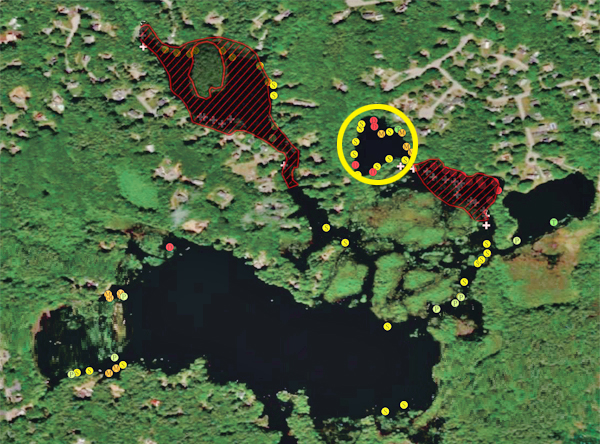
Last August, a biologist from the Corporation's lake management consultant observed fanwort at the locations noted by the different-colored points on the above map (the colors represent levels of density). The two cross-hatched areas were chemically treated last year. The consultant has recommended treating Dug Pond (circled) in 2023, and deploying divers to hand-pull fanwort observed elsewhere in Foster's Pond.
Dug Pond and Foster's Pond are separate water bodies, separated by a narrow berm. Dug Pond, a 3.9-acre former gravel pit, is owned by the Town of Andover; Foster's Pond, a 120-acre "great pond," is owned by the Commonwealth of Massachusetts. Pursuant to an Order of Conditions approved by the Andover Conservation Commission, the Foster's Pond Corporation is designated to implement a lake management program for both.
The Corporation's Board of Directors annually makes lake management recommendations to the Conservation Commission, which has the final say on any chemical treatments.
Dug Pond was last treated for fanwort in 2015. Divers have played a major role in forestalling the need for any chemical treatment of Dug Pond over the course of eight years, while reducing the need for widespread treatment of Foster's Pond. Since 2019, the Corporation has deployed divers to pluck out smaller fanwort infestations in Dug Pond and Foster's Pond before they become so dense that chemicals must be used.
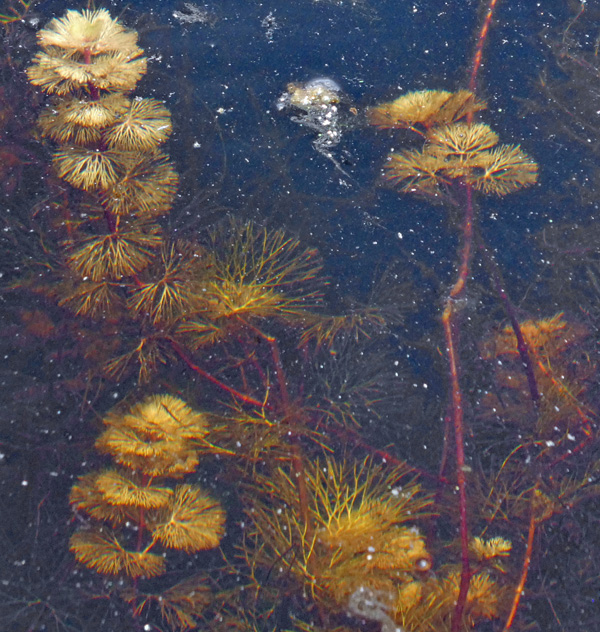
August 1: Fanwort in one of last year's treatment areas showing signs of "chlorosis" - the bleaching effect triggered by low doses of Sonar herbicide. Healthy fanwort is bright green.
Fanwort is almost impossible to eradicate. The delicate plant fragments easily, and a small piece - carried off by a bird, a beaver, a boat or a breeze - can take root and start a new colony. As fanwort has continued to re-emerge in both Dug Pond and Foster's Pond, chemicals have been used to treat small sections of Foster's Pond when infestations have grown too large for divers to tackle. The last whole-lake treatment of Foster's Pond was conducted in 2015.
While diving slowed the spread of fanwort in Dug Pond, the tipping point was reached last year. In 2022, divers spent three days attempting to remove fanwort from Dug Pond, but by then the infestations there had become so widespread and dense that the divers' efforts were barely perceptible. The dive team gave up on Dug Pond, moving on to smaller infestations in Foster's Pond. The divers recommended chemical treatment for Dug Pond. In its subsequent report, the Corporation's lake management consultant agreed.
Annual Survey: Fanwort Strategy Is Working
December, 2022
The annual late-season vegetation and water quality survey of the Pond indicates that the Corporation's strategy of using both chemicals and diver hand-pulling to control fanwort is keeping the persistent invasive weed in check.
The survey, which was conducted by the FPC's lake management consultant in August and documented in a 59-page report submitted to the Corporation this month, found an uptick in the area of open water covered by fanwort as compared to 2021. The survey estimated 7.4% of the open water was infested with fanwort in August, up from 4.6% last year. The survey, which was conducted before this year's chemical treatment of 14.5 acres had taken full effect, noted that the treated fanwort was dying. In addition, following the survey, divers spent 10 days pulling out fanwort by the roots. They estimated that they removed 7 cubic yards of the weed.
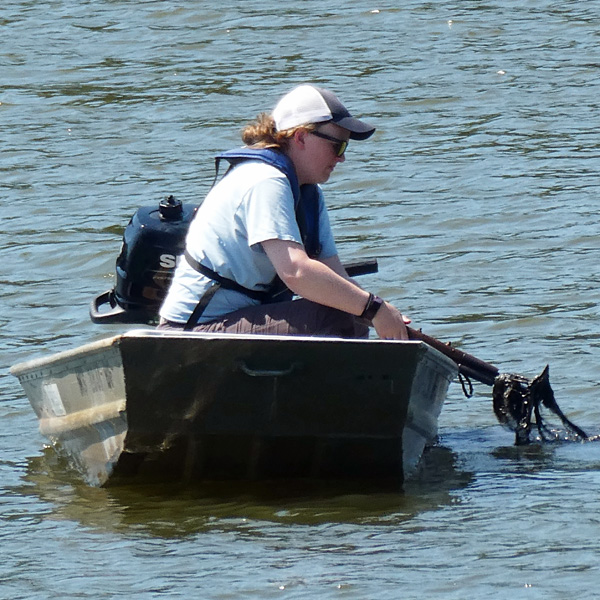
August 4: Solitude Lake Management biologist Kristen Veinotte rakes up vegetation at a data point in the Main Pond.
Before the FPC initiated control measures in 2005, fanwort covered 54.5% of the Pond's open water.
The survey found that native plant species in the Pond were about as diverse as in past surveys, and that water quality remained good. In particular, the concentration of E. coli, the key indicator of potentially unhealthful water, was far below the threshold of concern in all basins.
This year's survey was the 15th commissioned by the FPC. The survey is conducted by an aquatic biologist at 61 pre-set locations which are georeferenced in a hand-held GPS unit, to provide consistent data on the health of the Pond and the effect of weed-control efforts. The biologist rakes the bottom at each point, identifying vegetation and estimating their density. The biologist also collects water samples at five locations. The samples are analyzed on several parameters to provide data on water quality, including concentrations of phosphorous, a limiting nutrient for algae. Elevated phosphorous levels are a problem, particularly in the Main Pond.
After a Break, Diving for Fanwort Resumes
September, 2022
Armed with a new map of fanwort infestations, a two-man dive team resumed the exhausting task of pulling the invasive weeds, one by one, from the silty shallows of Foster's Pond.
Divers had spent three days in early August going after fanwort in Dug Pond and the Channel, but had to decamp for a month to fulfill other commitments. In the meantime, a biologist from the Corporation's lake management consultant completed the Pond's annual vegetation survey - producing a detailed map of current fanwort locations.
The divers returned to Foster's Pond on September 6. Using the new map, the divers began with an infestation in the Main Pond that yielded an estimated two cubic yards of fanwort in a few hours.
The map pinpointed several infestations in the Main Pond, as well as some in the passage between the Main Pond and the Mill Reservoir and the passage between the Main Pond and the Channel.
The aim of the diving is to remove fanwort infestations that are too small to be chemically treated but which - left to themselves - would spread and ultimately require treatment of the Main Pond, the largest basin of Foster's Pond.
'Main Pond' Basin Successfully Treated for Blue-Green Algae
August, 2022
The Main Pond - the largest basin in Foster's Pond - was successfully treated on August 5 for blue-green algae. Immediately after the treatment, blue-green algae counts in the Main Pond plummeted to safe levels.
Despite oppressive heat and little rain throughout the month, the threat of blue-green algae disappeared from the Main Pond and never materialized in the Pond's other major basins.
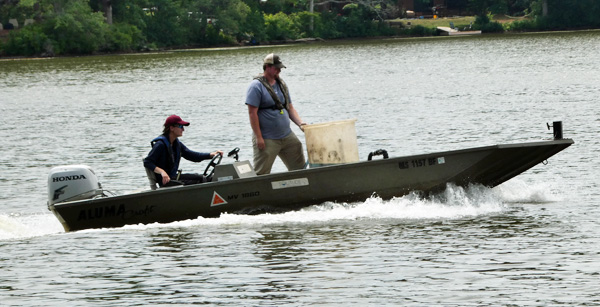
August 5: Solitude Lake Management technicians Vinnie Notaro (standing) and Serena Bet circle the Main Pond applying copper sulfate to control blue-green algae.
Prior to the August 5 treatment, laboratory analysis of a water sample from the Main Pond indicated an elevated concentration of blue-green algae, which can cause gastrointestinal illness in kids and prove fatal to pets. In higher concentrations, adults, too, may experience skin irritations and even more serious health effects. The concentration from the Main Pond sample collected on July 28 was 56,000 cells/mL. At 70,000 cells/mL, the Massachusetts Department of Public Health recommends that people have no contact with the water. A water sample from the Outlet Cove (between the Channel and the Dam) contained only 550 cells/mL, far below a level which would warrant concern.
In the wake of the treatment, a water sample from the Main Pond drawn August 8 showed a 90% drop in the concentration of blue-green algae, down to just 5500 cells/mL. The Outlet Cove, which was not treated, increased slightly to 2100 cells/mL. Both levels are a small fraction of the Mass. DPH threshold for posting a health advisory.
As the month wore on, and drought conditions deteriorated from "severe" to "extreme" as determined by the U.S. Drought Monitor, blue-green algae continued to decline. A Corporation volunteer sampled all four major basins in the Pond on August 22, and laboratory analyses detected no blue-green algae in three: the Main Pond, the Outlet Cove, and the Azalea Drive basin. The fourth - the Mill Reservoir - had a mere 29 cells/mL. Two August 29 samples from the Main Pond yielded concentrations of only 470 and 480 cells/mL, respectively.
Volunteers had been observing water clarity at various locations in the Pond. Declining clarity can be a sign of increasing levels of algae. Clarity in the Main Pond dipped sharply in late July, triggering the first of what became several rounds of laboratory tests.
Divers Pull Fanwort from Untreated Basins
August, 2022
A two-man dive team spent three days hand-pulling fanwort from the silty bottom of Dug Pond, as the Corporation continues trying alternatives to controlling invasive weeds solely with chemicals.
Cousins Quintin and Cody Arsenault from Connecticut-based Sterling Aquatic LLC donned SCUBA gear and grasped their dive bags as they embarked on the slow, arduous and messy task of gently plucking the fragile plants out by the roots while blinded by swirling sediments.
August 1: Professional divers Scott (left) and Cody Arsenault run through their safety checklist before diving for fanwort in Dug Pond.
The first assignment: clearing (or at least thinning) infestations in Dug Pond and the Channel. From there, the divers will move on to infestations in the Main Pond and the passage between the Main Pond and the Mill Reservoir.
The hope is that, if relatively small fanwort colonies can be removed before they get too large, whole-lake chemical treatments may be needed less frequently. The last whole-lake treatment (including Dug Pond) was in 2015.
Fifteen of the Pond's 120 acres are being treated with an herbicide this year. Chemical control is safe, more effective on large infestations than hand-pulling, and cheaper on a per-acre basis. But the state-authorized herbicide can't effectively be used on small infestations, as it must be maintained at the appropriate concentration in the water surrounding the target plants for 90 days - and that's pretty much impossible unless an entire basin is treated. The Azalea Drive Basin and the Outlet Cove are undergoing treatment.
On August 1 - a little more than five weeks after an initial treatment and a week after application of a "booster" dose - fanwort in the two treated areas were showing distinct signs of dying. Instead of the bright green color of healthy fanwort, the treated plants were turning white - exhibiting "chlorosis" as the herbicide left them vulnerable to the bleaching effects of sunlight. A second booster treatment, if needed, will be administered in early September.

August 1: Fanwort in the Azalea Drive Basin showing signs of "chlorosis" - the bleaching effect triggered by low doses of Sonar herbicide. Healthy fanwort is bright green.
Outlet Cove and Azalea Basin Receive "Booster" Weed Treatment
July, 2022
Two areas of the Pond totaling 15 acres received a second round of herbicidal treatment July 25. The initial dose of a slow-acting herbicide was applied to the same areas on June 24 as part of the by-now familiar summer-long protocol to control infestations of fanwort.
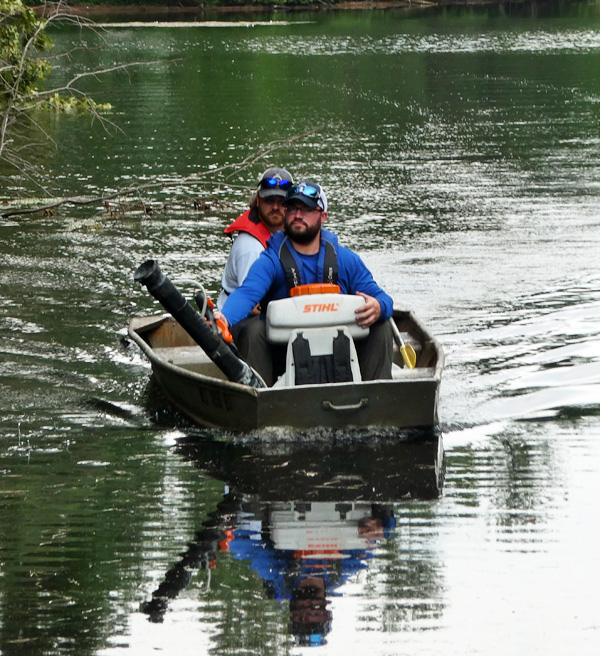
July 25: Technicians from Solitude Lake Management circling the Outlet Cove near the Dam, spreading clay pellets infused with Sonar. Residents are advised not to use treated water for irrigation for the remainder of the summer.
The approved herbicide most effective in killing fanwort is fluridone, sold under the brand name Sonar. It works at very low concentrations, but has a short half-life. That means that, to maintain enough of it in the water, one or two "booster" treatments must be applied every month or so over a period of 90 days.
Sonar works by preventing the plants from producing carotene, a sort of sunblock that protects chlorophyll the plants need to survive. Without the carotene, the plants bleach out and die, a process known as chlorosis.
The herbicide is applied by broadcasting clay pellets infused with Sonar. The applicator uses a portable GPS unit and calibration controls on the spreader to determine the right rate of pellet distribution. The pellets release the Sonar over time as the clay breaks down in the water. The target concentration is measured in parts per billion - a level so low that Sonar is permitted by regulators to be applied in public water supplies.
Fanwort Treatment Targets Outlet Cove and Azalea Basin
June, 2022
Two areas of the Pond totaling 14.5 acres were treated for fanwort on June 24. The same areas will be treated once or twice more during the summer, at intervals of about a month, in order to maintain the proper concentration of the slow-acting herbicide used to control the invasive weed.
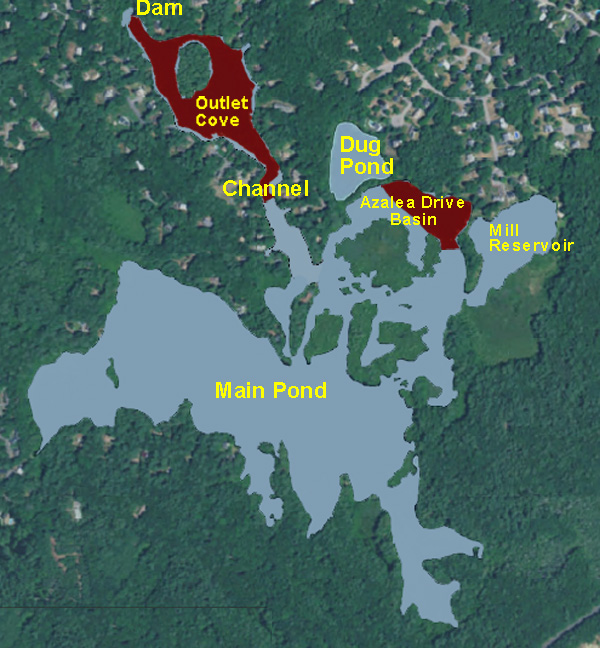
Areas in red were treated with a slow-acting herbicide on June 24 and will be treated twice more at intervals of about month. Residents are advised not to use treated water for irrigation for the remainder of the summer.
The treatment areas were first identified by Solitude Lake Management last year in its 2021 vegetation survey of the Pond. A follow-up survey in May, after the bright-green fanwort plants began to emerge from bottom, confirmed the presence of dense infestations.
The treatment is conducted under a three-year Order of Conditions approved by the Andover Conservation Commission and a treatment program authorized by the Commission in May.
Conservation Commission Approves Treatment Program for 2022
May, 2022
The Andover Conservation Commission unanimously approved the Corporation's 2022 weed treatment plan, setting the stage for chemical treatments of fanwort and algae during the summer.
The vote came at the Commission's May 3 meeting, based on an extensive written submission by the Corporation.
The plan - adapted from recommendations by Solitude Lake Management last year following its 2021 vegetation survey of the Pond - calls for the treatment of an estimated 15 to 17 acres where dense stands of fanwort were observed. The precise acreage, and the target areas, won't be known until Solitude conducts another survey early this summer to see where fanwort survived the efforts of a dive team that was deployed last fall.
The approved plan also authorizes algaecide treatments in the event blue-green algae return in concentrations that threaten a hazardous bloom.
And if spiny naiad- another troublesome invasive weed that has appeared from time to time - is detected, the plan authorizes spot treatments in affected areas.
Consultant Recommends Treatment and Diving Continue Based on 2021 Survey
January, 2022
The Corporation's lake management consultant recommends continuation of efforts to control fanwort through a combination of chemical treatment and diver hand-pulling.
The recommendation by Solitude Lake Management is based on results of the 2021 comprehensive vegetation survey, the fourteenth late-summer analysis the Corporation has commissioned since 2004. To conduct the survey, a biologist rakes up and analyzes vegetation at 61 data points, which are georeferenced in a hand-held GPS unit, to provide data on the health of the Pond and the effect of weed-control efforts. The survey also collects data on water quality, including concentrations of phosphorous, a key nutrient for algae.
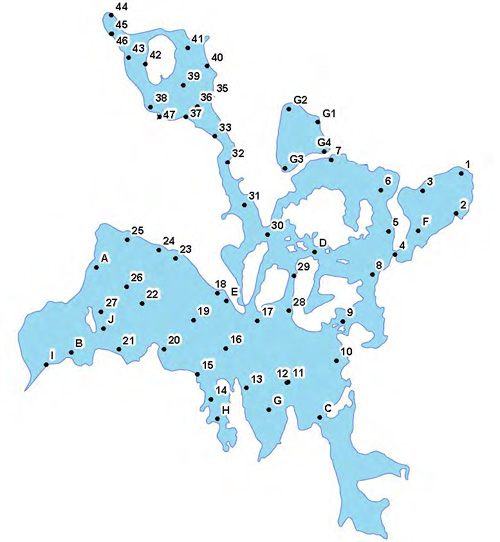
To determine plant species and their density for the annual vegetation survey, a biologist rakes the bottom and analyzes the plants at 61 data points.
Solitude conducted the vegetation survey last August, after completing chemical treatment of the six-acre Mill Reservoir but before divers had begun hand-pulling fanwort elsewhere in the Pond. Solitude's 51-page report was submitted to the Corporation October 30.
The survey recorded a slight uptick in fanwort cover - from 2% in 2020 to 4.6% in 2021 - and recommended chemical treatment of dense fanwort stands in the Channel, the Outlet Cove, and the Azalea Drive Basin. But, as the report noted, divers subsequently spent a week pulling out fanwort in the Channel and the Outlet Cove. Their work likely reduced the fanwort cover to the 2020 level. Solitude recommended an early-summer survey of both areas, after fanwort has emerged from the bottom, to determine whether those infestations were reduced to the point where treatment will not be needed in 2022.
In most respects, the survey found water quality in the Pond to be good, with coliform well below levels of concern throughout the water body. Phosphorous levels in the Main Pond, the Mill Reservoir and the Outlet Cove were higher than in 2020, probably reflecting periods of greater-than-usual rainfall washing nutrients into the Pond. The concern is that higher levels of phosphorous can support blue-green algae blooms.
Conservation Commission Extends FPC Role for Three Years
November, 2021
The Andover Conservation Commission unanimously extended for three years the long-standing Order of Conditions which authorizes a lake management program for Foster's Pond and designates the Foster's Pond Corporation as the entity in charge of implementing it.
The vote, which came at the Commission's November 16 meeting, continues an integrated management program first authorized in 2005. The Order covers herbicide use, winter drawdowns, hydro-raking, and nutrient management. The Order has been amended from time to time, as new chemicals and non-chemical alternatives became available - and as additional invasives and blue-green algae emerged as problems. The November 16 vote, extending the Order to January, 2025, made no changes in the program.
Divers Pursue Fanwort Where Chemical Treatments Left Off
September, 2021
A team of divers spent four days at the end of August and the beginning of September hand-pulling fanwort from Dug Pond and several shallow coves of Foster's Pond, plunging into sediment-laced water to remove plants, one at a time, by the roots.
The effort marked a continuation of the Corporation's ongoing experiment to find practicable alternatives to chemical treatment, which until the last couple of years has proved to be the only method of reliably controlling large infestations of the persistent invasive weed which once dominated the Pond.
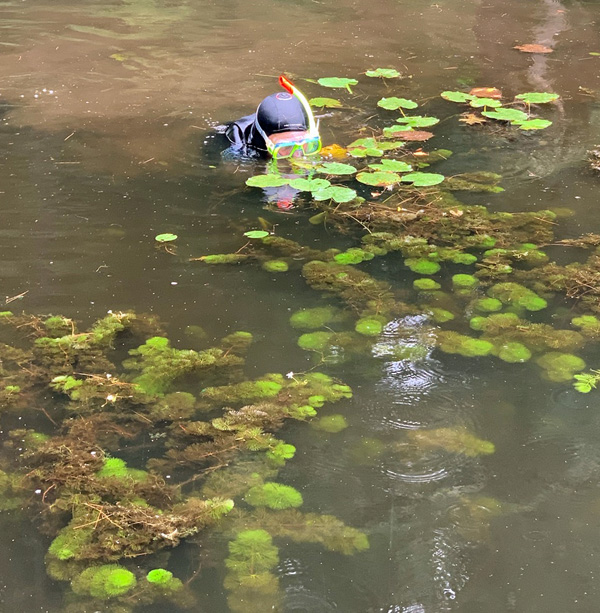
September 1: Ted Fiust, a thirty-year veteran of diving professionally to remove invasive weeds, pursues a stand of fanwort intertwined with water lilies near Rock Island.
The task is anything but pleasant. Any disturbance of the bottom sediments turns the water to the color of chocolate milk, instantly blinding the diver, who must grope for the roots of the next plant. And each delicate plant must be carefully removed, without fragmenting its fragile stems and sending off pieces to float away and start new infestations.
The two-person dive team was headed by Ted Fiust, a 30-year veteran of the dwindling ranks of experienced professionals who don SCUBA gear to hand-pull invasive weeds. Most of his one-time competitors now favor the use of industrial-scale equipment too cumbersome to navigate the shallows of Foster's Pond.
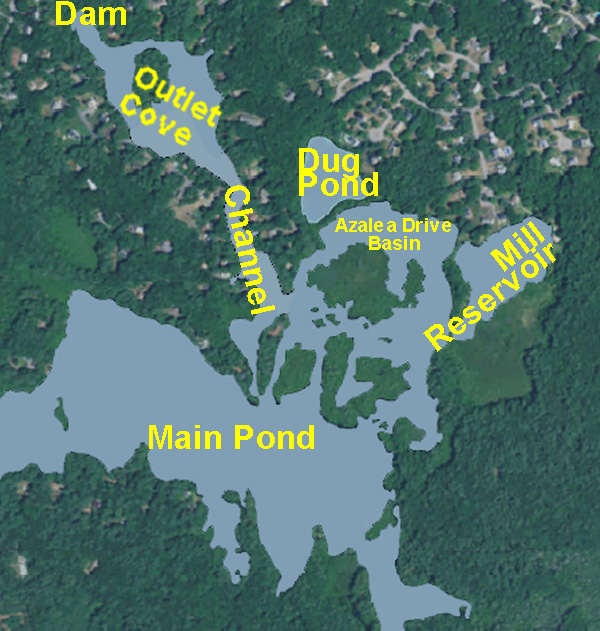
Divers went after fanwort in Dug Pond, the Azalea Drive Basin, the Channel, and the Outlet Cove. The Mill Reservoir was chemically treated for fanwort earlier in the summer.
The divers targeted fanwort infestations in Dug Pond, the Azalea Drive Basin, the Channel, and the Outlet Cove. The divers stayed out of the Mill Reservoir, the one basin that was chemically treated in 2021. No fanwort appeared to have survived the treatment there.
A survey in early September found that dense infestations of fanwort in all of the areas targeted by the divers had been largely - but not completely - removed. Not surprisingly, given the impossibility of seeing the results until sediments have had a few hours to settle, the divers left behind isolated plants in nearly all of the basins, but an estimated 85-95% of the plants had been taken out.
Two Treatments Combat Blue-Green Algae Thriving on Unrelenting Heat and Rain
August, 2021
Blue-green algae reared their ugly heads for a second time this summer, triggering the need for a repeat algaecide treatment of about half of the Pond. The Main Pond, the Channel, the Outlet Cove and the Dam were treated August 31, having previously been treated on July 22.
Water samples collected on August 18 revealed an elevated blue-green algae count in the Main Pond. The Outlet Cove had a lower count, but conditions there and in the Channel have deteriorated since the samples were collected. Water clarity was down, and blue-green scum had been observed.
Blue-green algae, or cyanobacteria, can cause gastrointestinal illness in kids and prove fatal to pets. In higher concentrations, adults, too, may experience skin irritations and even more serious health effects.
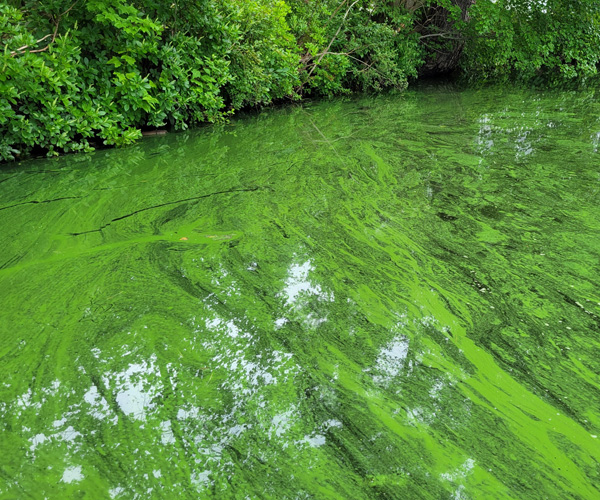
July 15: Blue-green algal scum on the Main Pond. It's especially important to keep kids and pets away from blue-green algae, which can cause intestinal distress in children and be fatal to dogs. Adults, too, can experience illnesses from exposure to high concentrations.
The August 18 count count in the Main Pond was 27,000 cells/ml. This level is well below the 70,000 cells/ml threshold at which the Massachusetts Department of Public Health recommends that people have no contact with the water. But cyanobacteria can grow explosively, triggering blooms that health authorities consider dangerous.
Beginning mid-July, the Corporation posted warning signs and sent out emails alerting residents and visitors to avoid blue-green scum on the surface of the Pond. Even after a treatment, scum can appear, particularly along shorelines.
Blue-green algae - which was detected in parts of the Pond in July - had all but disappeared in the wake of a July 22 treatment to prevent a potentially hazardous bloom. Samples taken from three basins on August 2, after that first treatment, had showed reassuringly low concentrations of the noxious stuff, which has closed a number of ponds in the area.

The Main Pond, the Channel, and the Outlet Cove received an algaecide treatment on August 31. The same three basins were treated on July 22.
But algae treatments are temporary. If conditions are right - like hot weather, especially if combined with torrential rain washing nutrients into the Pond - blue-green algae can return. That's what happened over the course of the month following the first treatment..
The first treatment was arranged after laboratory analysis of water samples taken on July 15 had turned up elevated concentrations.
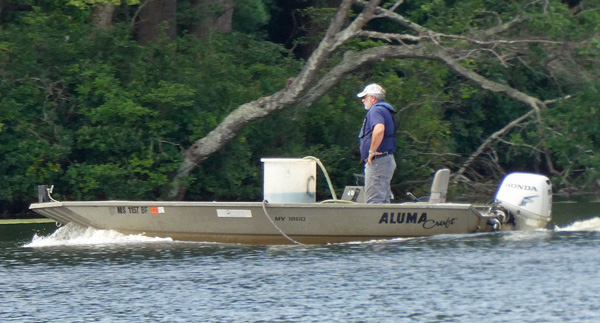
August 31: Dominic Meringolo, senior environmental engineer at Solitude Lake Management, infuses the Main Pond with a copper sulfate solution to kill blue-green algae. It was the second treatment in s summer notable for heavy rains and repeated heat waves.
The Main Pond, the Channel, and the Outlet Cove were infused with copper sulfate on July 22. Samples from the Main Pond and the Outlet Cove had exhibited low to moderate algae counts, and blue-green algal scum was observed in both basins. The Channel, which connects the basins, was not sampled but was also treated as a precaution.
Laboratory analysis of the July 15 samples indicated 21,000 cyanobacteria cells per milliliter in the Main Pond and 19,000 cells/ml in the Outlet Cove, which lies between the Channel and the Dam.
As of August 2, the blue-green algae counts were way down. The count in the Main Pond plummeted to only 1200 cells/ml, and the Outlet Cove was down to 1400 cells/ml - way below any threshold of concern. The Mill Reservoir had a low concentration in July and no detectable amount on August 2. It was not treated.
The likely cause of the increased algae counts was the unrelenting rain and hot weather which characterized the Summer of '21. Torrential rains wash nutrients into the Pond, and the heat fosters explosive growth.
Mill Reservoir Gets Booster Treatment for Fanwort
July, 2021
The Mill Reservoir received the second of three herbicidal treatments aimed at curbing infestations of fanwort in the 5.7-acre basin.
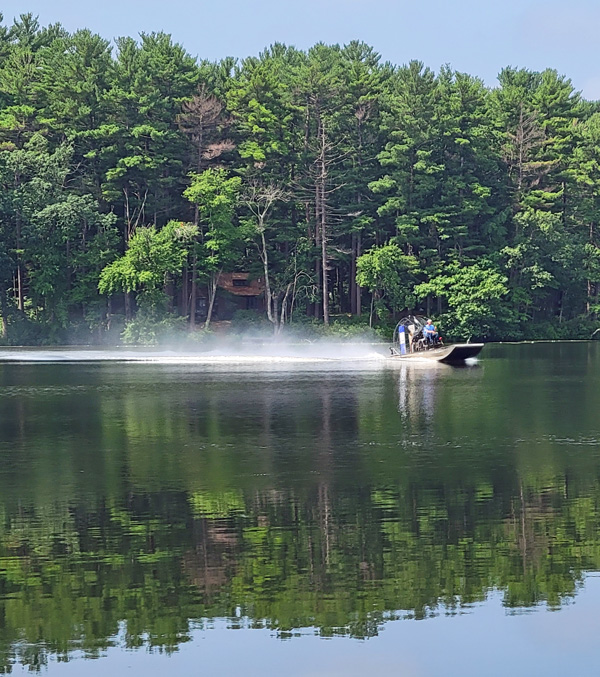
July 15: John Maday, an environmental scientist from Solitude Lake Management, guides the company's 16-foot airboat toward the Mill Reservoir.
The summer-long treatment regimen requires maintaining a low concentration of a slow-acting chemical in the target area for 90 days. Because the chemical - fluridone, sold under the brand name Sonar - breaks down relatively quickly, it must be replenished every three to six weeks to be effective.
The Mill Reservoir was closed to recreational uses for the day, and shoreline residents have been cautioned not to irrigate with treated water for the summer.
The first treatment was administered on June 3, and the final treatment will be applied in August.
The treatment was recommended by the Corporation's lake management consultant and was approved by the Andover Conservation Commission in May.
Mill Reservoir Treated for Fanwort
June, 2021
The Mill Reservoir began a summer-long treatment regimen to rid the 5.7-acre basin of fanwort.
The first of three herbicidal treatments was administered on June 3. Two "booster" treatments will follow at intervals of about 30 days. The aim is to maintain a low concentration of Sonar, the slow-acting herbicide which has proven effective in killing fanwort, for 90 days.
The Mill Reservoir was closed for the day of treatment, reopening June 4. Owners of the three residential properties on the Mill Reservoir were cautioned not to use Pond water for irrigation throughout the course of treatment.
The treatment was recommended by the Corporation's lake management consultant and was approved by the Andover Conservation Commission in May.
Conservation Commission Approves 2021 Lake Management Plans; Mill Reservoir to be Treated for Fanwort
May, 2021
The Andover Conservation Commission unanimously approved 2021 lake management recommendations submitted by the Foster's Pond Corporation.
The vote came at the Commission's May 18 virtual meeting. The FPC had asked for approval of a list of twelve participants in this year's hydro-raking program, as well as authorization to treat the Mill Reservoir for fanwort, spot-treat around 3.5 acres of the Pond for spiny naiad, and - if needed - apply copper sulfate in the event of an impending bloom of blue-green algae.
The treatment proposals were contained in a year-end report last December by the Corporation's lake management consultant.
Annual Commission approvals are required by the Order of Conditions which governs the Corporation's lake management program.
The first of three Mill Reservoir treatments was originally scheduled for May 27, but the treatment was postponed after a survey indicated that fanwort had not yet emerged. The Mill Reservoir will be closed to recreational uses just for the day of treatment, After the first treatment, and for the remainder of the summer, residents are advised not to use water from the 5.7-acre basin for irrigation.
2020 Vegetation Survey Recommends Mill Reservoir Treatment
January, 2021
A year-end report submitted by the Corporation's lake management consultant has recommended treating the 5.7-acre Mill Reservoir for fanwort, as well as spot-treating ten other widely scattered locations - totaling about 3.5 acres - for spiny naiad.
In another 9.3 acres, the consultant recommended that the Corporation continue its experiment with the deployment of divers to hand-pull small infestations of fanwort.
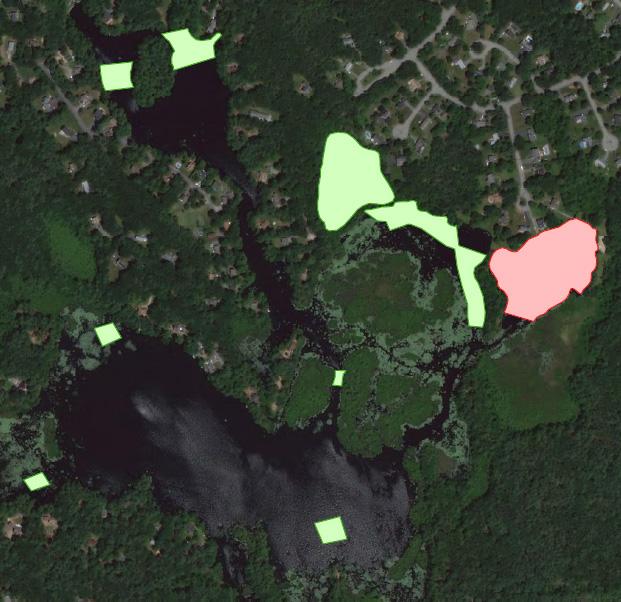
The Corporation's lake management consultant has recommended treating the 5.7-acre Mill Reservoir (shown in red) for fanwort and deploying divers to remove smaller infestations in another 9.3 acres (shown in green).
The recommendations are based on a comprehensive vegetation survey conducted by a Solitude Lake Management biologist in September, following a summer in which invasive weeds in various locations were targeted with a combination of chemical treatments and hand-pulling. The survey - which involved analysis of vegetation at 61 prescribed data points - was the 13th conducted by the Corporation to track the health of the Pond and the effect of management strategies.
The survey indicated that fanwort, which is nearly impossible to eradicate, remains well under control, even though it continues to pop up in isolated pockets. Dense fanwort mats choked 54.5 per cent of the Pond's 120 acres before the Corporation started its lake management program in 2005. As of last fall, fanwort was found in just 2.1 per cent of the Pond.
Spiny naiad, the only other invasive weed that has cropped up in significant quantities from time to time, has never covered as much of the Pond, but - like fanwort - it spreads easily, is hard to get rid of, and forms a dense monoculture which drives out native plants. It is too brittle to be pulled out by hand without sending fragments off to establish new colonies, so chemical control is the only effective containment method.
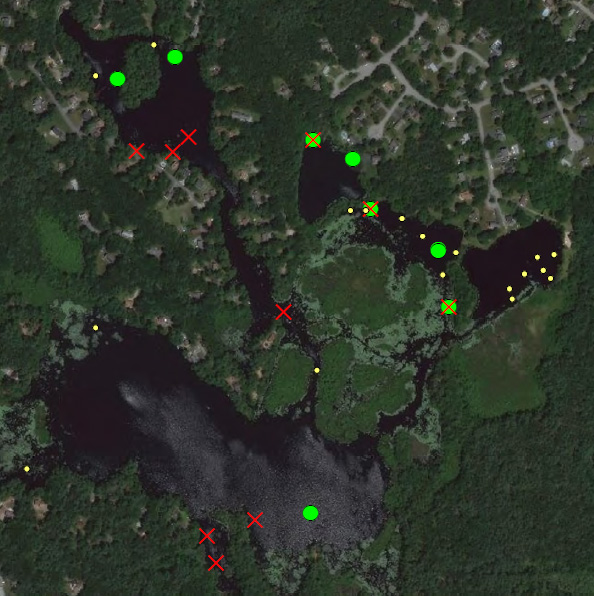
Last September's comprehensive vegetation survey - the 13th conducted by the Corporation - pinpointed locations of fanwort (green and yellow dots) and spiny naiad (red x's). The green dots are among the 61 sampling points used in prior surveys to collect data for comparison from year to year.
Fanwort is even harder to manage. One chemical - fluridone, sold under the brand name Sonar - is the the only practicable means of combatting large infestations. Sonar has a favorable safety profile - regulators allow up to 20 parts per billion in public drinking water supplies, while concentrations of less than half that are effective in killing fanwort - but Sonar isn't of much use in killing small, isolated infestations that can emerge in between large-scale treatments. The chemical can't effectively be applied to small areas, as it rapidly diffuses into the whole water body, becoming too diluted to work.
One way to deal with small fanwort infestations is to ignore them until they spread to the point where a large-scale treatment is warranted. Another approach is to somehow smother or remove them. But that is harder than it sounds. Fanwort is fragile, and it spreads by fragmentation. Trying to rake up plants or pluck them out is counterproductive, as the plants just break up, sending out bits and pieces which float away and root in different locations. And trying to place lightproof barriers on top of growing plants is almost impossible in the thigh-deep muck which covers most of the Pond bottom.
Over the last two years, the Corporation has been experimenting with another technique: deploying divers to descend to the bottom and carefully remove individual plants by their roots. It is a slow and painstaking process, during which the swirling muck instantly blinds the diver, who must proceed by touch to remove each root ball. And in some parts of the Pond - like the Mill Reservoir - the water is too murky to even locate the stem of each plant.
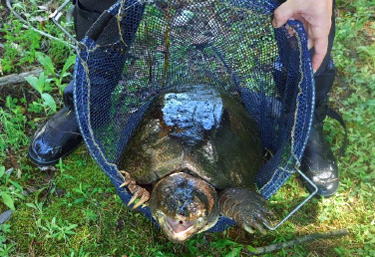 |
| Diving in the murky sediments of Foster's Pond didn't sit well with this long-time inhabitant, who came within an inch of biting the hand of an intruder probing the bottom for the roots of a fanwort plant. The snapper's carapace measured 24 inches in length. He (or she) was quickly and safely returned to the water. |
Despite these challenges, the Solitude survey indicates promising results from the two-year diving experiment. Hand-pulling by divers has been largely successful in relatively clear water where the divers have repeatedly dived in the same location, going back down a day or more after sediments have settled to remove plants they missed the first time. Last summer, divers removed an estimated 2.5 cubic yards of fanwort from 8 acres. The Solitude survey found no - or markedly reduced - infestations of fanwort in areas that divers had worked and reworked.
Diving is not without hazards. An "After Action Report" submitted by the Corporation's dive contractor, Aquatic Vision LLC, included a picture of a large snapping turtle - its carapace was 24 inches long - that was briefly detained after it came within an inch of biting the hand of one startled diver.
The Corporation's Board of Directors, after reviewing Solitude's report, will present to the Andover Conservation Commission a game plan for this year's vegetation control operations pursuant to the Order of Conditions which governs the management of Foster's Pond.
Dive Team Takes on More Fanwort
August, 2020
A dive team resumed hand-pulling isolated stands of fanwort from scattered locations throughout the Pond. Diver Rodrigo Pavani, assisted by Lucy Pereyra in a surface craft, uprooted armloads of the invasive weed in the Outlet Cove, the Channel, and a shallow cove in the Main Pond near Willard Circle.
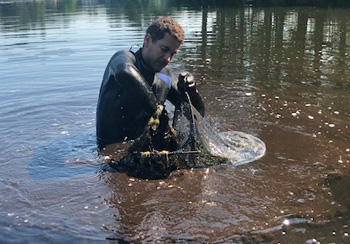 |
| August 24: Rodrigo Pavani stuffs an armload of fanwort into his dive bag as bottom sediments turn the water temporarily opaque. Photo by Julianne Stoughton. |
Most of the locations had been mapped earlier by a biologist. The Willard Circle infestation was identified by resident Julianne Stoughton.
The fanwort locations were pinpointed after divers wound up ten days of work - most of it in Dug Pond - in July. Fanwort is a resilient plant that is easily spread and almost impossible to eliminate entirely.
Diving for fanwort is a slow-going and messy business, as the Pond's soft sediments instantly blacken the water and obscure near-by plants.
Although chemical treatment can be cheaper and more efficient, it is not cost-effective to treat small stands. The Corporation's deployment of divers is aimed at eliminating minor infestations before they expand, reducing the use of chemicals as much as possible.
Channel Treated for Spiny Naiad
August, 2020
Two sections of the Channel running from the Outlet Cove to the Main Pond were treated August 13 for infestations of spiny naiad, a pesky invasive that periodically blankets parts of the Pond.
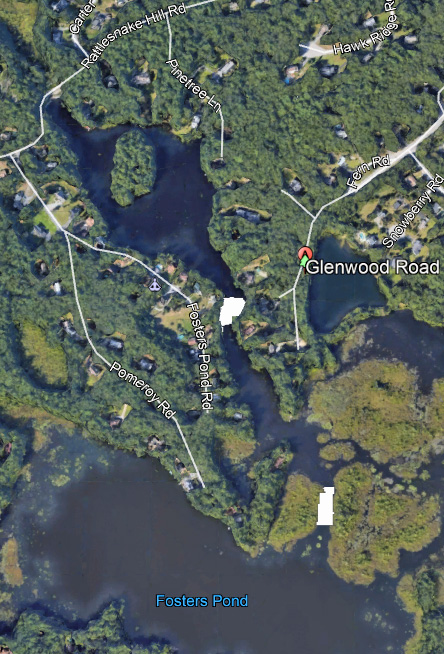
August 13: Two sections of the Channel between the Outlet Cove and the Main Pond were treated for spiny naiad. The treatment areas are shown in white.
Spiny naiad, which grows so densely that it drives out native plants, is extremely difficult to get rid of. Mature plants drop millions of seeds, which can take a year or two to sprout. It is controlled with diquat, a contact herbicide that is injected into the water using subsurface hoses that are calibrated to insure the proper concentration.
The treatment plan was approved by the Andover Conservation Commission last May, pursuant to an Order of Conditions that governs the Corporation's lake management program.
Health Advisory: Stay Alert for Blue-Green Algae
August, 2020
Small concentrations of blue-green algae were detected in three basins of the Pond on August 3: the Main Pond, the Mill Reservoir, and the Outlet Cove. No blue-green algae were found in the Azalea Drive basin.
The concentrations were not a cause for alarm, and were too low to warrant treatment. However, as in any New England pond in the summer, residents and visitors should look out for blue-green scum on the surface. If you see any, avoid contact, keep your kids away, and don't let your dog drink or get it on their fur.
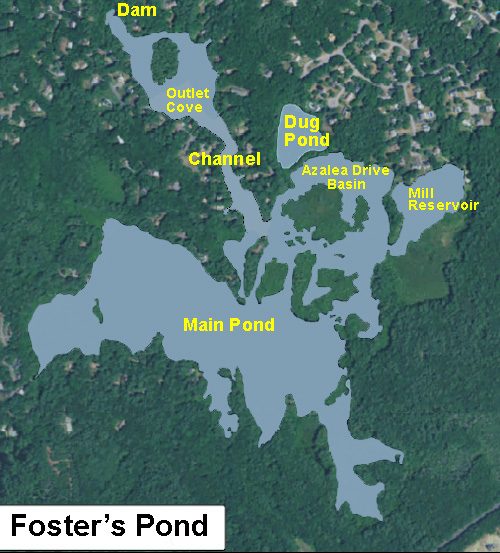
August 3: Small, non-concerning amounts of blue-green algae were detected in the Main Pond, the Mill Reservoir, and the Outlet Cove. Although the concentrations were too low to treat, residents and visitors are cautioned to be on the lookout for - and avoid - blue-green scum which could accumulate at the shoreline of the affected basins.
Blue-green algae scum can range in color from avocado (the pulp, not the skin) to various shades of aquamarine. The floating brownish mats seen in many parts of the Pond are not blue-green algae. Blue-green algae scum is most likely to accumulate against a shoreline, in near-calm conditions, blown in by a gentle breeze.
Almost every year now the Pond is threatened with blooms of blue-green algae, which pose a health danger particularly to children and pets. With no paid staff and no lab at our beck and call, the FPC can't guarantee to keep the Pond safe. Volunteers have been taking periodic readings of the water clarity in different parts of the Pond (a drop in clarity is the first indication of a possible problem) and collecting samples for laboratory examination.
2nd Booster Treatment Applied to Fanwort Target Area
July, 2020
A small area of the Pond at the mouth of the Mill Reservoir received its third dose of slow-acting herbicide aimed at a persistent infestation of fanwort.
The treatment was applied July 20, about four weeks after the last application. At least one more treatment is expected.
Divers Finish Their Work at Primary Targets
July, 2020
A dive team scoured Dug Pond, the Azalea Drive basin, and two channels near the mouth of the Mill Reservoir in the final day of an effort to clear the areas of scattered infestations of fanwort.
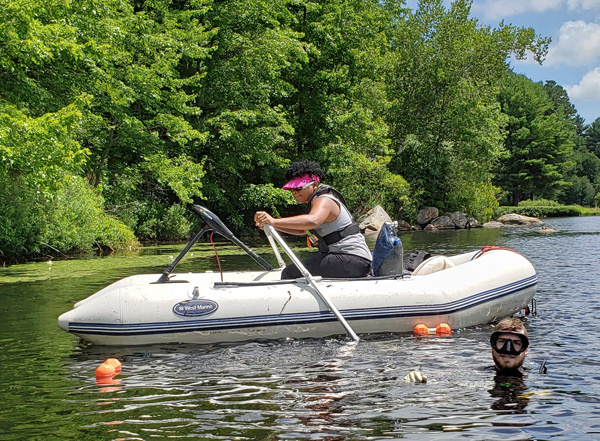
July 16: Dive attendant Lucy Pereyra maneuvers the equipment raft as Warren Cohen surfaces while scouting for fanwort in the Azalea Drive basin. Orange floats mark infestations targeted for hand-pulling.
The Corporation began experimenting last year with the deployment of divers to reduce reliance on chemicals to control fanwort. This year, divers spent 10 days pulling out small infestations or single plants in the target areas.
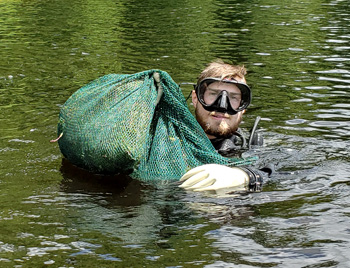 |
| July 16: Warren Cohen hoists a pair of dive bags afer filling them with fanwort pulled from the bottom of the Azalea Drive basin. |
A larger infestation at the mouth of the Mill Reservoir has been undergoing chemical treatment.
Hand-pulling by divers is an excruciatingly slow process, in which individual and highly fragile plants must be carefully plucked from the bottom without losing any fragments which can float off and root elsewhere. The task is made harder by the Pond's silty bottom, which blackens the water and blinds the diver at the slightest disturbance.
While diving is not cost-effective for larger infestations, chemical treatment is not cost-effective for small colonies or solitary plants. The hope is that if divers can successfully eliminate minor infestations, the scope or frequency of chemical treatments can be minimized.
Residents and visitors are encouraged to report sightings of fanwort. Click here for more information and to get started. Depending on the size of the infestation, it may be assigned to a diver this season or targeted for chemical treatment next year.
1st Booster Treatment Applied to 1.5-Acre Target Area
June, 2020
A small area of the Pond off Bessie's Point at the mouth of the Mill Reservoir received a second dose of slow-acting herbicide targeting a persistent infestation of fanwort.
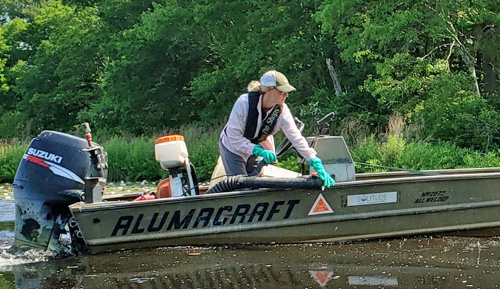
June 23: Solitude Lake Management biologist Kara Swiloski steers through the narrow channel at the mouth of the Mill Reservoir while guiding the nozzle of a spreader which scatters clay pellets infused with a slow-acting herbicide.
The approved herbicide most effective in controlling fanwort is fluridone, sold under the brand name Sonar. It works at very low concentrations, but has a short half-life. That means that, to maintain enough of it in the water, "booster" treatments must be applied every 3 or 4 weeks over a period of 90 days.
Sonar works by preventing the plants from producing carotene, a sort of sunblock that protects chlorophyll the plants need to survive. Without the carotene, the plants bleach out and die, a process known as chlorosis.
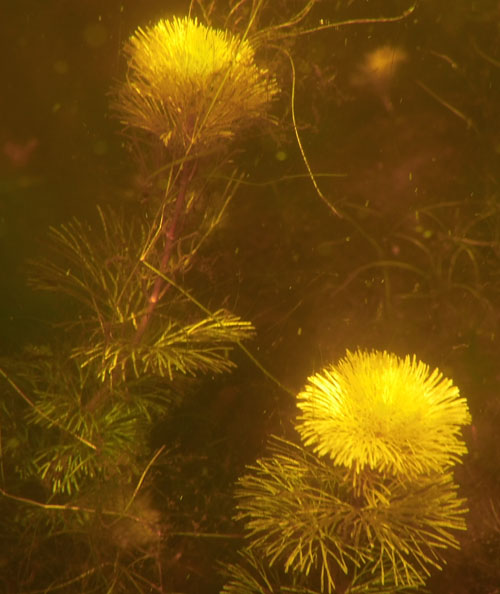
June 17: Fanwort off Bessie's Point in the initial stages of chlorosis, the bleaching effect of treatment with Sonar. Photo by David Armas.
The target area received its initial Sonar treatment on June 4. By June 17, plants in the target zone were already showing signs of chlorosis.
Non-Chemical Management in the Spotlight
June, 2020
With only a tiny area of the Pond targeted this year for chemical treatment of fanwort, the focus shifted to the Corporation's program of non-chemical lake management techniques.
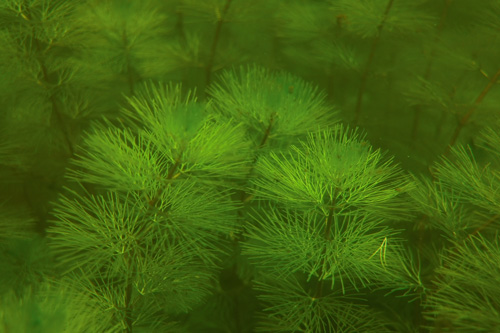
June 14: Fanwort in Dug Pond, as seen by a diver. Before the FPC began its lake management program, this resilient invasive weed was the dominant plant in Foster's Pond. Left unchecked, fanwort can choke a lake to death, robbing a water body of enough oxygen to kill fish. Photo by David Armas.
A diver began hand-pulling fanwort from Dug Pond on June 12, continuing an experiment that began last year with mixed results.
David Armas, owner of Aquatic Vision LLC, worked his way around the shore of the 3.9-acre former gravel pit, carefully plucking plants out by the roots and stuffing them into a dive bag.
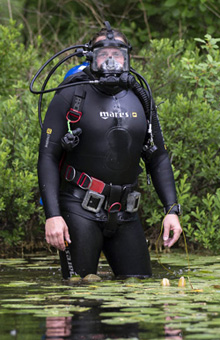 |
| June 14: David Armas pauses in full gear (above) while removing fanwort from Dug Pond. Armas displays (below) one of the plants, tediously plucked from the silt-covered bottom. Photos by Winslow Townson. |
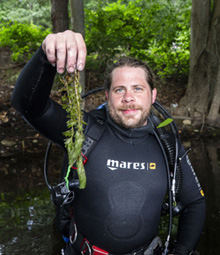 |
It's painstaking work, since fanwort is a delicate invasive weed which spreads by fragmentation - and is easily fragmented. Moreover, there's enough silt on the bottom of Dug Pond that the normally gin-clear water explodes into inky blackness as the rootball emerges, blinding the diver.
The plan was for Armas to clear Dug Pond of several fanwort infestations, then look for small stands in the rest of Foster's Pond. The minor infestations are too small to treat chemically but capable of swiftly multiplying to Pond-clogging colonies too wide-ranging to pull out by hand.
Meanwhile, after a several-week delay occasioned by the coronavirus pandemic's disruption of the Andover Conservation Commission meeting schedule, the hydro-rake arrived on the Pond.
Hydro-raking is the longest-running component of managing Foster's Pond, dating back to 1992. Financed by individual shoreline owners who pay to have their properties raked, the process improves overall Pond health by removing nutrient-rich sediments and organic matter which contribute to algae blooms.
Ten property owners signed up for 42.5 hours of hydro-raking, most of it in the Main Pond. The work began on June 16.
This year's program of chemical control - confined to a 1.5-acre fanwort infestation at the mouth of the Mill Reservoir - will continue with a booster treatment on June 23. Killing fanwort by chemical means requires maintaining a low dose of a slow-acting herbicide in the water for at least 90 days. The only effective chemical authorized for use in Massachusetts has a relatively short half-life, and thus must be re-applied every month or so during the growing season.
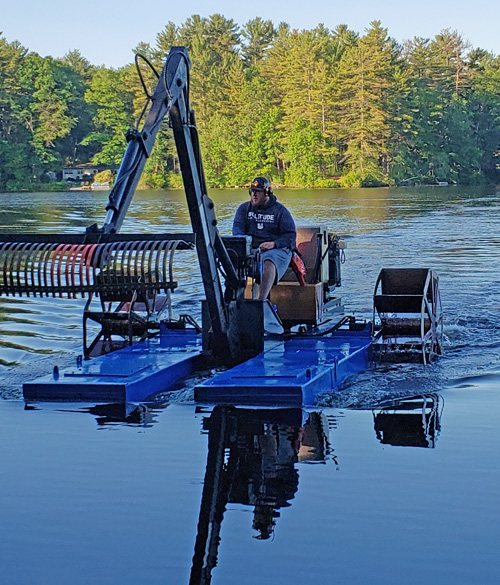
June 16: The hydro-rake begins work in the Main Pond. With 41.5 hours of raking scheduled, the job was expected to take about a week.
1.5 Acres Get Fanwort Treatment After Conservation Commission OKs Plan
June, 2020
A small but persistent infestation of fanwort was treated June 4.
The target area comprises 1.5 acres of a narrow channel off Bessie's Point in the Goldsmith Woodlands, at the mouth of the the Mill Reservoir.
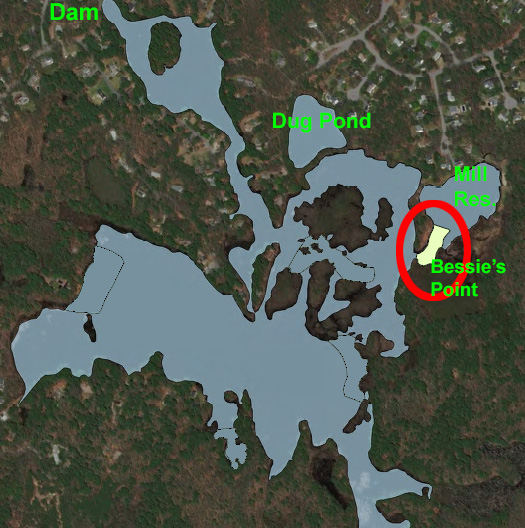
June 4: The targeted treatment area was of 1.5 acres (circled) in a narrow channel at the mouth of the Mill Reservoir off Bessie's Point in the Goldsmith Woodlands.
The treatment was unanimously approved by the Andover Conservation Commission at its first-ever virtual meeting May 26. It was the Commission's first meeting since early March, due to the coronavirus epidemic.
The targeted infestation has proved hard to eradicate. It had been chemically treated in 2018, without much effect, as part of a broader treatment covering 15 of the Pond's 120 acres. The 2018 treatment was successful - except for the infestation in the channel at Bessie's Point. Why there? Treatment requires maintaining a low concentration of Sonar - the slow-acting herbicide approved by the State for controlling fanwort - over at least a three-month period. But the Bessie's Point channel apparently had a sufficient current to wash out the chemical before it could do its job.
Last year, the Corporation experimented with an alternative - using divers to remove fanwort in this location. But that experiment didn't work out, either. In that channel, the fanwort, which is very fragile and spreads by fragmentation, intertwines with the much sturdier stems of water lilies, making it impossible to get at the fanwort roots without launching countless fanwort fragments.
This year's plan reverts to chemical treatment, but with a modification. The duration of the treatment regimen will be extended by adding to the schedule of "booster" treatments. Normally, Sonar treatments have been successful in Foster's Pond with only two follow-up applications a month apart. This year, a third booster treatment will be added if the fanwort has not succumbed after just two follow-ups.
The Conservation Commission's May 26 meeting also greenlighted other aspects of the Corporation's lake management plan for 2020. The Commission approved treatments, if needed, for blue-green algae and spiny naiad later this summer. The Commission also approved plans for this year's hydro-raking. The Commission's annual votes to approve weed treatments and hydro-raking are required under the Order of Conditions which governs the Corporation's lake management program.
2019 Year-End Report Sets Stage for 2020
January, 2020
A comprehensive report on the Corporation's 2019 weed control efforts recommends continuing the strategy of treating small concentrations of invasive weeds with herbicides, supplemented by deploying divers to hand-pull infestations on an experimental basis.

To determine plant species and their density for the annual vegetation survey, a biologist rakes the bottom and analyzes the plants at 61 data points.
The centerpiece of the report is the compilation of data from a comprehensive vegetation survey conducted on August 19. It was the 12th systematic late-summer survey commissioned by the Corporation to track the results of our lake management program. As in prior surveys, a biologist rakes up and examines vegetation at dozens of data points georeferenced in a hand-held GPS unit. The survey also measures water quality, including concentrations of phosphorous, a key nutrient for algae.
Following chemical treatment of 7.5 of the Pond's 120 acres for fanwort last year, the survey found scattered fanwort infestations in an estimated 2% of the Pond (about 2.5 acres). Before the Corporation launched its lake management program, fanwort was the dominant plant in the Pond, covering more than half of the open water.
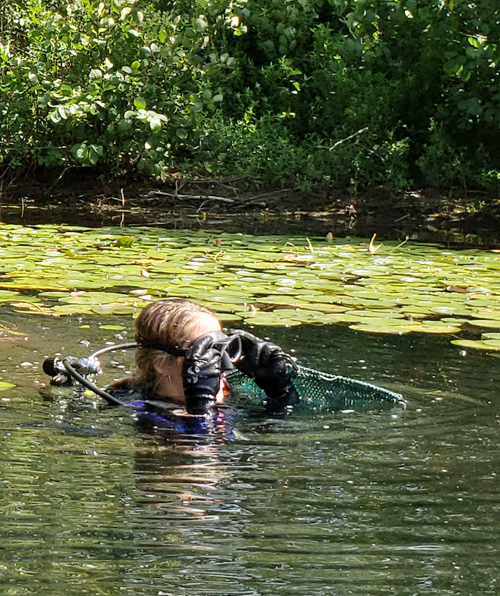
August 5, 2019: A diver adjusts her goggles before starting to hand-pull fanwort in Dug Pond.
The report chronicles mixed results from an experiment with using divers to hand-pull fanwort at two locations. In the narrow channel at the mouth of the Mill Reservoir, dense mats of fanwort proved resistant to the divers' efforts. When the divers attempted to use suction equipment, they were quickly blinded by clouds of silt. Abandoning that approach, they fared no better trying, without the aid of equipment, to disentangle the delicate fanwort stems from water lilies in the same location.
As the report notes, the divers fared better in Dug Pond, which has a gravel bottom and fewer lilies. The report recommends experimenting further in 2020 with the deployment of divers in Dug Pond.
The 49-page report was prepared by the Corporation's long-time consultant, Solitude Lake Management. The report was submitted to the Corporation at the end of December.

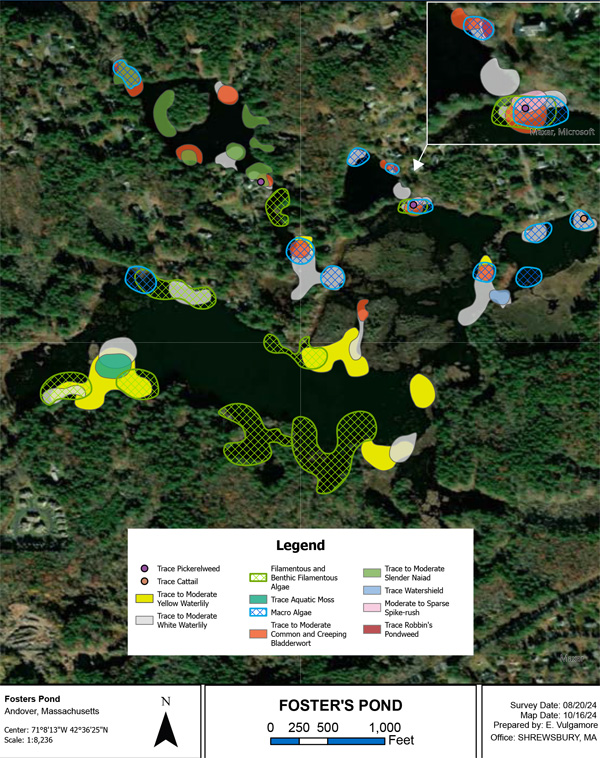

 Questions? Comments? Contact us at
Questions? Comments? Contact us at